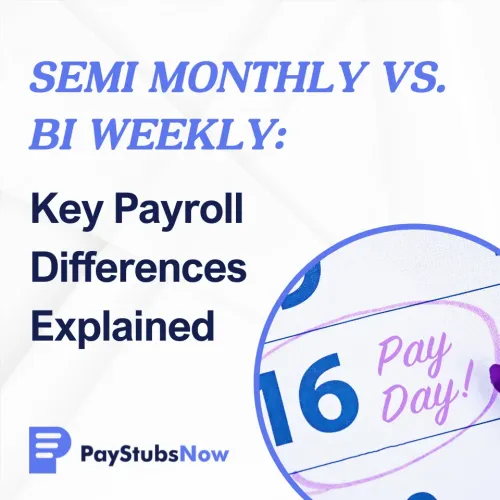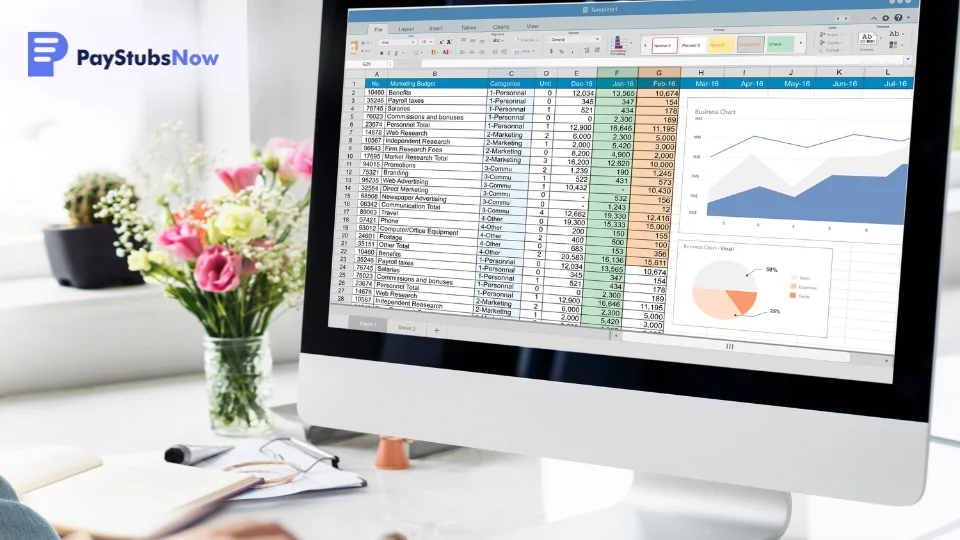


Choosing between semi-monthly and bi-weekly pay schedules? You're not the only one scratching your head. The differences might seem insignificant, but they can affect everything from payroll processing to employee satisfaction.
In this guide, we'll break down how each schedule works, what makes them different, and which one might be the better fit for your team. Whether you're running payroll for the first time or thinking about switching things up, we'll help you make a confident, informed choice.
A semi-monthly pay schedule delivers paychecks twice a month on fixed dates (like the 15th and 30th), resulting in 24 paychecks yearly. Only 19.8% of U.S. private businesses use this method, according to the Bureau of Labor Statistics . For business owners and freelancers,this approach simplifies payroll and aligns with monthly expenses.
The two standard semi-monthly pay periods are:
While pay dates remain fixed, each period contains a different number of workdays. When paydays fall on weekends or holidays, payments typically process on the previous business day.

A bi-weekly pay schedule means employees are paid every other week on the same day, typically on a Friday, resulting in 26 pay periods per year. This is the most common payroll frequency in the U.S., used by approximately 43% of private U.S. establishments .
Bi-weekly schedules align neatly with 7-day workweeks, making them especially practical for hourly employees and overtime calculations. While it may require more payroll runs annually, it offers predictable timing that employees often prefer.
It's easy to confuse semi-monthly and bi-weekly schedules, but they have key differences that impact both employers and employees.
Category
Semi-Monthly Payroll
Bi-Weekly Payroll
Definition
Employees are paid twice per month on fixed calendar dates.
Employees are paid every two weeks on the same day of the week.
Pay Dates
Common dates include the 1st & 15th or the 15th & last day of the month.
Paydays are consistently spaced every two weeks (e.g., every other Friday).
Paychecks per year
24
26
Example
Jan 1, Jan 15, Feb 1, Feb 15, etc.
Every other Friday, regardless of the calendar date.
Frequency
Twice a month
Every two weeks
Pay Date Pattern
Fixed calendar dates
Consistent weekday, floating dates
Budgeting Impact
May be harder for hourly workers due to varying period lengths.
Often easier to budget with consistent two-week cycles.
Semi-monthly schedules typically suit salaried employees better because the fixed dates align with monthly benefit deductions and make salary calculations straightforward.
Bi-weekly schedules often work better for hourly employees. The consistent 14-day periods simplify overtime calculations and align with standard two-week work schedules.
 For Salaried Employees:
For Salaried Employees:
Calculating pay for salaried employees is straightforward. Simply divide their annual salary by 24.
For example, an employee with a $60,000 annual salary would receive a gross pay of $2,500 on each paycheck ($60,000/24).
For Hourly Employees:
For hourly workers, you multiply the total number of hours worked within the specific pay period by their hourly rate.
Since pay periods have a variable number of days (e.g., 15 days in the first half of March vs. 16 in the second), the gross pay for hourly employees will often differ from one paycheck to the next.
For Salaried Employees:
Calculating bi-weekly pay for salaried employees is simple. Divide the employee's annual salary by 26 to determine their gross pay for each paycheck. For example, someone earning $52,000 per year would receive $2,000 every two weeks ($52,000 ÷ 26 = $2,000).
For Hourly Employees:
To calculate pay for hourly employees, multiply the number of hours worked during the two-week pay period by their hourly rate. Since bi-weekly schedules always cover 14 days, tracking weekly hours and applying overtime rules (for hours over 40 in a week) is more straightforward than with semi-monthly pay.
Understanding the advantages and challenges of both payroll schedules helps you make an informed decision for your business.
Successfully transitioning to or optimizing a semi-monthly pay schedule requires careful planning and clear communication. Here are some best practices to follow:
Most businesses opt for either the 1st and 15th or the 15th and last day of the month. Consider your cash flow patterns and avoid dates that conflict with major business obligations.
When pay dates fall on weekends or holidays, establish a consistent policy. Most employers pay on the preceding Friday to ensure employees receive funds on time.
Some states mandate specific pay frequencies or maximum days between payments. Check your state's Department of Labor requirements before implementing semi-monthly payroll. States like California and Michigan have strict payday requirements that may affect your schedule.
 Ensure your payroll software can handle:
Ensure your payroll software can handle:
Give employees at least 30 days' notice before switching pay schedules. Provide:
Switching to or maintaining a bi-weekly payroll schedule requires some planning to ensure accuracy and consistency. Here are a few best practices to keep your process running smoothly:
 Selecting between semi-monthly and bi-weekly payroll depends on your workforce composition, administrative capabilities, and business needs.
Selecting between semi-monthly and bi-weekly payroll depends on your workforce composition, administrative capabilities, and business needs.
Choose semi-monthly payroll if you have:
Industries like professional services, tech companies, and corporate offices often prefer semi-monthly schedules.
Opt for bi-weekly payroll if you have:
Choosing between semi-monthly and bi-weekly pay isn’t just about timing; it affects how you manage cash flow, handle overtime, and keep employees happy. Semi-monthly pay fits salaried roles and monthly billing cycles, while bi-weekly is often better for hourly teams.
No matter your setup, staying organized and accurate with payroll is key. Paystubsnow makes it easy to generate professional paystubs, invoices, and tax forms—on demand, without the hassle of complex software or subscription fees.
Generate Paystubs Now and simplify your payroll process in just a few clicks.